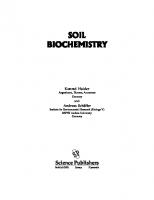Biochemistry Bootcamp.com
131 18
English Year 2023
Recommend Papers

- Author / Uploaded
- Bootcamp.com
File loading please wait...
Citation preview
TABLE OF CONTENTS
Biochemistry
1.
Cell Biology
2.
Lysosomal Storage Diseases
3.
Connective Tissue
4.
Energy Production
5.
Carbohydrates
6.
One-Carbon Metabolism
7.
Oxidative Stress
8.
Glycogen
9.
Lipid Metabolism
OUTLINE 1.
Biochemistry: Cell Biology
2.
3.
4.
Cell Trafficking A. Endoplasmic Reticulum B. Cell Trafficking to cis-Golgi C. Golgi D. Anterograde Transport from trans-Golgi E. Endocytosis I-Cell Disease A. Pathophysiology B. Presentation C. Diagnostics D. Management E. Complications F. Differential Diagnoses Signal Recognition Particle A. Signal Sequence and SRP B. SRP Receptor and Translocon C. Transmembrane Proteins Peroxisome A. Overview B. Very-Long-Chain Fatty Acid β-Oxidation C. Branched-Chain Fatty Acid ɑ-Oxidation D. Peroxisome Synthetic Processes
5.
6.
7.
8.
Ubiquitin-Proteasome system A. Overview B. Ubiquitin C. Proteasome D. Cell Cycle Regulation E. Proteasome Inhibitors Cytoskeleton A. Overview B. Actin C. Intermediate Filaments D. Microtubules Primary Ciliary Dyskinesia A. Pathophysiology B. Presentation C. Diagnostics D. Management Sodium-Potassium Pump A. Overview B. Pump Mechanism C. Applications
Biochemistry: Cell Biology
Cell Trafficking •
Endoplasmic Reticulum: • Rough ER: Ribosomes, near nucleus, protein synthesis, N-linked glycosylation • Smooth ER: No ribosomes, near membrane, lipid synthesis, glucose-6-phosphatase • Vesicular Trafficking to Cis-Golgi: • COPII: Anterograde transport → Cis-Golgi • COPI: Retrograde transport → ER (endocytosis) • Golgi: • Post-translational modifications: • Modify N-oligosaccharides of Asn, add O-oligosaccharides of Ser/Thr • Sulfation of Tyr • Addition of mannose-6-phosphate for proteins destined for lysosome • I-cell disease: Failure to phosphorylate mannose residues → Inclusions • Anterograde Transport from Trans-Golgi: • Secretory vesicle to cell membrane → Exocytosis • Clathrin-mediated transport → Late endosome → Lysosome • Endocytosis: • Clathrin-mediated endocytosis → Early endosome → Late endosome • → Trans-Golgi for retrograde transport to ER (COPI-mediated) • → Lysosome for degradation
Bootcamp.com
Biochemistry: Cell Biology
I-Cell Disease •
•
•
• • •
Pathophysiology: • Golgi normally adds mannose-6-phosphate to proteins destined for lysosome • Defect in N-acetylglucosamine-1-phosphotransferase → Failure of Golgi to phosphorylate mannose → Digestive enzymes NOT tagged for lysosome → Transport of digestive enzymes extracellularly → ↑ Lysosomal substances in serum • Buildup of cell debris inside lysosomes (inclusion bodies) • Autosomal recessive Presentation: • Young child, developmental delay/failure to thrive • Coarse facial features, corneal clouding → blindness • Skeletal deformities/↓ Mobility, kyphoscoliosis, claw hand deformity • Hepatomegaly, gingival hyperplasia Diagnostics: • ↓ N-acetylglucosamine-1-phosphotransferase enzyme activity • Amniotic fluid/chorionic villi (prenatal) or WBCs (postnatal) • ↑ Serum lysosomal enzymes, normal urinalysis • Inclusion bodies and vacuoles in peripheral blood lymphocytes Management: • No cure; symptomatic treatment, nutritional support, physical therapy Complications: • CHF, pneumonia, otitis media, atlantoaxial instability Differential Diagnosis: • Mucopolysaccharidoses (Hurler/Hunter syndromes) → ↑ Urinary glycosaminoglycans
Bootcamp.com
Biochemistry: Cell Biology
Signal Recognition Particle •
•
Signal Sequence and Signal Recognition Particle: • Signal sequence (SS): String of hydrophobic amino acids on proteins destined for ER • Export or membrane integration • SS attracts signal recognition particle (SRP) → Binds SS and stops translation • (+) Anti-SRP: Polymyositis/dermatomyositis • (+) Anti-Jo primary diagnostic target • ↑ Muscle enzymes, symmetrical proximal muscle weakness • Polymyositis: No cutaneous involvement • Dermatomyositis: Heliotrope eyelid rash, Gottron papules SRP Receptor and Translocon: • SRP brings nascent protein/ribosome complex to ER membrane, binds SRP receptor • Ribosome passed to translocon (translocation channel), SRP detaches • SS opens translocon and binds, translocation continues, threads through as a large loop • Protein complete → SS degraded by signal peptidase → Translocon closes • Protein released into ER lumen, escorted to Golgi for vesicular trafficking • Transmembrane proteins made by changing location of SRP or adding stop sequences • Failure of SRP → Cytosolic buildup of proteins
Bootcamp.com
Biochemistry: Cell Biology
Peroxisome •
•
•
•
Overview: • Peroxisomes degrade fatty acids, amino acids, uric acid → Generate peroxide (H2O2) • Compare to lysosomes and proteasomes • Lysosomes: Degrade endocytosed materials and cell debris • Proteasomes: Degrade ubiquitinated proteins Very-Long-Chain Fatty Acid (VLCFA) β-Oxidation: • Fatty acids >22 carbons too large to transport into mitochondria, break into medium-chain FAs • Each cycle cleaves 2C • Electrons transfer to O2, unlike in the mitochondria (ATP synthesis-coupled) → H2O2 (toxic) • Catalase reaction degrades peroxide or uses in detox reactions • Protects cell from oxidative damage • Catalase (+) bacteria (e.g. Staphylococci) → ↑ Pathogenicity • Adrenoleukodystrophy: ABCD1 mutation → ↓ VLCFA import → ↓ β-Oxidation → ↑ VLCFA • Adrenal glands → Adrenal insufficiency • White matter → Cognitive impairment, neonatal seizures, hearing loss Branched-Chain Fatty Acid α-Oxidation: • Mostly brain and liver, cleaves 1C • Substrate is phytanic acid • Refsum disease: Disorder of peroxisome α-Oxidation → ↑ Phytanic acid • Ascending polyneuropathy, scaly skin, cataracts, shortening of 4th toe, epiphyseal dysplasia Peroxisome Synthetic Processes: • Cholesterol, bile salts, ethanol, amino acids, plasmalogens • Zellweger syndrome: PEX mutation → ↓ Peroxisome biosynthesis • ↓ Synthetic function and VLCFA oxidation • Hypotonia, seizures, hepatomegaly
Bootcamp.com β-Oxidation
Catalase reaction
α-Oxidation
Biochemistry: Cell Biology
Ubiquitin-Proteasome System •
Overview: • Proteasome degrades endogenous ubiquitinated proteins (specific) • Misfolded proteins, cell cycle regulation, anti-apoptotic molecules (vs. lysosome for exogenous proteins) • Ubiquitin: • Regulatory protein tag added to proteins destined for proteasome, ATP-initiated • Conjugation cascade by adding ubiquitin (Ub) to lysine residues E1: Activation, transfers Ub to E2 (one) • • E2: Conjugation, presents Ub to E3 (several) • E3: Ligation, facilitates Ub attachment to target (many, specific) • Process repeats → Poly-Ub chain; Mono-ubiquitination non-degradative • Proteasome cleaves peptide bonds via ATP hydrolysis • Ubiquitylation reversible by deubiquitylating enzymes (DUBs) • Proteasome: • 26S barrel-shaped catalytic enzyme complex in nucleus and cytoplasm • Regulatory particles bind, cleave poly-Ub chain, denature target protein, feed to proteolytic core • Disorders of Lewy Bodies (Parkinson & Lewy Body Dementia): ↓ Ub-proteasome activity → Neurodegeneration • ↓ Parkin activity (E3) or ↑ DUB activity → ↑ α-synuclein protein → Lewy bodies • Brainstem: Constipation, depression, fluctuating blood pressure • Substantia Nigra: Motor symptoms (resting tremor, bradykinesia) • Cortex: ↓ Memory and executive function • Cell Cycle Regulation: • Cyclin B + CDK1 → Entry into M phase • Ub-mediated proteolysis of Cyclin B → Exit M phase • Proteasome Inhibitors: • Inhibition of proteolytic subunit → Cell degradation; Management of multiple myeloma and mantle cell lymphoma • G2-M phase cell cycle arrest → Induction of apoptosis • Accumulation of misfolded proteins, more frequent in cancer cells
Bootcamp.com
Biochemistry: Cell Biology
Bootcamp.com
Cytoskeleton • •
•
•
Overview: • Cytosolic protein filament network for transport, stability, movement, cell division Actin: • ~7 nm microfilaments in microvilli, stereocilia • G-Actin monomers + ATP → F-Actin polymers → Double helix • Migration, cytokinesis, muscle contraction (with myosin) Intermediate Filaments (IF): • ~10 nm filaments for stability (no motor proteins), varying structure, cross-linked by plectin • Cytokeratin (epithelial cells), vimentin (fibroblasts), desmin (muscle) • Glial fibrillary acidic protein (glial cells), lamins (cell nucleus); IHC markers detect neoplasm origin Microtubules (MT): • ~25 nm filaments in cilia and flagella, mitotic spindle • Associate with kinesin and dynein for cargo transport • Dynein: Retrograde (+ → –), used by Clostridium tetani, herpes simplex, poliovirus, rabies • Kinesin: Anterograde (– → +) • MT inhibitors: Mebendazole, Griseofulvin, Colchicine, Vinca alkaloids, Taxanes • ↓ MT polymerization or ↑ stability → Mitotic spindle failure → Neuropathy (Vincristine, Taxanes) Filament
Function
Size
Structure
Accessory Proteins
Actin
Muscle contraction, cytokinesis, migration
Small
Double helix
Myosin
IF
Stability
Medium
Varies
Plectin
MT
Movement, cell division
Large
Cylindrical
Kinesin, Dynein
Biochemistry: Cell Biology
Primary Ciliary Dyskinesia •
•
•
•
Pathophysiology: • Normal cilia structure: 9 doublet + 2 singlet microtubules (MTs), triplet centriole in basal body • Axonemal dynein of MTs links doublets, allows bending • Defect in dynein → Absent or dysmotile cilia → Dysfunctional ciliated epithelia • Developmental abnormalities from poor migration • Normal embryonic nodal cilia rotate in fixed direction → Thoracoabdominal laterality • Autosomal recessive Presentation: • Chronic productive cough, bronchiectasis; recurrent otitis, sinusitis, nasal polyps • Failure of ciliary epithelium to clear debris • Conductive hearing loss on Weber-Rinne test • Infertility (immotile sperm, ectopic pregnancy) • Displaced heart sounds (dextrocardia) • Kartagener Syndrome: Situs inversus, recurrent sinusitis, bronchiectasis Diagnostics: • Screening: ↓ Nasal nitric oxide • Chest x-ray: Dextrocardia +/- tram-track opacities (bronchiectasis) • Genetic tests for dynein arm mutations, abnormal cilia on electron microscopy Management: • No cure, management is supportive, maintain airway health
Bootcamp.com
Biochemistry: Cell Biology
Sodium-Potassium Pump • • •
Overview: • Active transport, ATP-powered: 3 Na+ out exchanged for 2 K+ into cell • Generates concentration gradients Pump Mechanism: • Cytoplasmic Na+ binds → ATP phosphorylates → Conformation change → Na+ release • K+ binds → Dephosphorylation → Return to original conformation → K+ release → Na+ binds, repeat Applications: • IV insulin to manage acute hyperkalemia • Insulin phosphorylates Na+/K+ pump → ↑ Pump activity → Shift K+ into cells → ↓ Serum K+ • Establish resting membrane potential via leaky K+ channels • Na+ pumped out, K+ pumped in → K+ leaks out down gradient → (-) Intracellular charge + • Na gradient allows cotransport/antiport of materials (e.g. kidney) • Na+/glucose cotransport down Na+ gradient → Reabsorption of glucose from urine • SGLT2 inhibitors: Block Na+/Glucose cotransport → ↓ Glucose reabsorption→ ↓ Blood sugar (Type II DM) + • Na /Ca2+ exchanger: 3 Na in, 1 Ca out; Na/K+ pump → ↓ [Na]i → Na+ enters cell along gradient → Ca2+ exchanged • [Ca2+]i in cardiac myocytes controls inotropy • Cardiac glycosides: Directly inhibit Na+/K+ pump → ↓ Na+/Ca2+ exchange → ↑[Ca]i → ↑ Inotropy
Bootcamp.com
OUTLINE
Biochemistry: Lysosomal Storage Diseases
1. Intro to Lysosomal Storage Diseases A. Overview of Lysosomal Storage Diseases B. Sphingolipidoses C. Mucopolysaccharidoses D. Approach to LSDs 2. Tay-Sachs Disease A. Pathophysiology B. Presentation C. Diagnostics D. Management E. Differential Diagnosis 3. Fabry Disease A. Pathophysiology B. Presentation C. Diagnostics D. Management E. Complications F. Differential Diagnosis 4. Metachromatic Leukodystrophy A. Pathophysiology B. Presentation C. Diagnostics D. Management E. Differential Diagnosis
5.
Krabbe Disease A. Pathophysiology B. Presentation C. Diagnostics D. Management E. Differential Diagnosis 6. Gaucher Disease A. Pathophysiology B. Presentation C. Diagnostics D. Management E. Differential Diagnosis 7. Niemann-Pick Disease A. Pathophysiology B. Presentation C. Diagnostics D. Management E. Differential Diagnosis 8. Mucopolysaccharidoses A. Pathophysiology B. Presentation C. Diagnostics D. Management E. Differential Diagnosis 9. Summary of LSDs
Biochemistry: Lysosomal Storage Diseases
Intro to Lysosomal Storage Diseases •
•
•
•
Overview of Lysosomal Storage Diseases (LSDs): • Healthy lysosome degrades cell debris • Lysosomal enzyme deficiency → ↑ Abnormal metabolic products • ↑ Ceramide derivative = Sphingolipidosis • ↑ Mucopolysaccharide = Mucopolysaccharidosis Sphingolipidoses: • Ceramide = Sphingosine + Fatty acid; Ceramide derivative = Ceramide + Head group • From breakdown of cell membranes • Lysosomal enzyme deficiency → ↑ Ceramide derivatives • Galactocerebroside, sphingomyelin, glucocerebroside or precursors (ceramide trihexoside, GM2) Mucopolysaccharidoses: • Mucopolysaccharides (glycosaminoglycans): Disaccharide repeats (Amino sugar + Uronic acid)n • From breakdown of proteoglycans (ECM) and peptidoglycans (cell wall) • Lysosomal enzyme deficiency → ↑ Mucopolysaccharides • Heparan sulfate, dermatan sulfate, common uronic acid (L-iduronate) Approach to LSDs: • Pathway interplay → Symptom overlap • Vignettes similar, differential rule-out may be more helpful than rule-in
Bootcamp.com
Biochemistry: Lysosomal Storage Diseases
Bootcamp.com
Tay-Sachs Disease •
•
• • •
Pathophysiology: • Healthy lysosome: GM2 ganglioside → Glucocerebroside, enzyme Hexosaminidase A • ↓ Hexosaminidase A → ↑ GM2 • Gangliosides involved in nerve function → Progressive neurodegeneration • Autosomal recessive, ↑ incidence in Ashkenazi Jews Presentation: • Developmental delay, weakness, hypotonia in an infant • Hyperreflexia, hyperacusis, vision/hearing loss, seizures, paralysis • No hepatomegaly Diagnostics: • Fundoscopy: Cherry-red macular spot • Biopsy: Onion-skin lysosomes Management: • Supportive care, death in childhood Differential Diagnosis: • Niemann-Pick: Shares cherry spot, Ashkenazi Jewish ↑ incidence, progressive neurodegeneration. Hepatosplenomegaly, older child • Krabbe: Shares age of onset, vision loss, developmental delay, weakness. No cherry spot, abnormal reflexes • Metachromatic Leukodystrophy: Shares developmental delay, neurodegeneration, weakness. Ataxia, toddler • Hurler: Shares age of onset, developmental delay. No weakness, no cherry spot, coarse facies, hepatosplenomegaly
Biochemistry: Lysosomal Storage Diseases
Bootcamp.com
Fabry Disease •
•
• • • •
Pathophysiology: • Healthy lysosome: Ceramide trihexoside (fibroblasts) → Glucocerebroside (cell membrane), enzyme α-galactosidase A • ↓ α-Galactosidase A → ↑ Ceramide trihexoside • Vessel endothelium, epithelium of many organs, dermal axons, smooth muscle → Multi-organ system involvement • X-linked recessive Presentation: • Triad of peripheral neuropathy/pain, hypohidrosis, angiokeratomas • Corneal clouding, cataracts • Older child/early adult Diagnostics: • α-Galactosidase A enzyme activity • Random X inactivation often → false (+) in men or (-) in women → Gene sequencing Management: • Recombinant enzyme therapy, can live into adulthood Complications: • Early TIA/stroke, progressive renal failure, cardiac complications Differential Diagnosis: • Vasculitis, rheumatic disorders, fibromyalgia: Often initial misdiagnoses, not complete symptom triad • Gaucher’s: Shares age of onset, treatment availability, lack of weakness. Hepatosplenomegaly, bone crises, no rash/hypohidrosis. • Hurler Syndrome: Shares corneal clouding. Melanocytosis, coarse facial features, developmental delay
Biochemistry: Lysosomal Storage Diseases
Metachromatic Leukodystrophy •
• •
• •
Pathophysiology: • Healthy lysosome: Sulfatides → Galactocerebroside, enzyme arylsulfatase A • Sulfatides major component of myelin • ↓ Arylsulfatase A → ↑ Cerebroside sulfate → Neurodegeneration • Autosomal recessive Presentation: • Weakness, hypotonia, and ataxia beginning ~2yo • Memory impairment, speech problems, developmental delay, dementia Diagnostics: • ↓ Arylsulfatase A activity, ↑ Cerebroside sulfate • CNS and peripheral nerve demyelination • Red-brown vacuoles in macrophage cytoplasm on Toluidine Blue (“metachromasia”) Management: • Supportive, usually death in childhood Differential Diagnosis: • Krabbe: Shares weakness, neuro symptoms only. Infant




![Биохимия. (Biochemistry) [Том 1]](https://ebin.pub/img/200x200/biochemistry-1.jpg)
![Биохимия. (Biochemistry) [Том 3]](https://ebin.pub/img/200x200/biochemistry-3.jpg)


![Biochemistry [5 ed.]](https://ebin.pub/img/200x200/biochemistry-5nbsped.jpg)
![Biochemistry [6ed]
0495390410, 9780495390411](https://ebin.pub/img/200x200/biochemistry-6ed-0495390410-9780495390411.jpg)